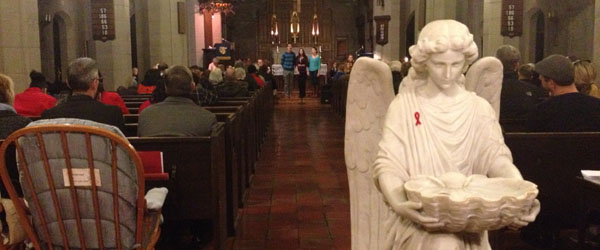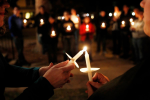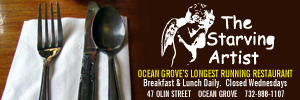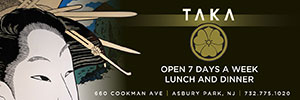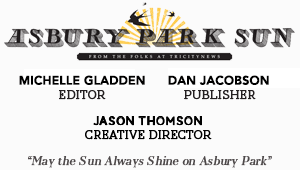The Center commemorates 25th annual World AIDS Day
Candlelight walk ends with memorial service to honor those afflicted
The Center in Asbury Park held their 21st candlelight walk and memorial service in observance of the 25th annual World AIDS Day Sunday.
World AIDS Day takes place annually on December 1. Around the globe, people don red ribbons, the color chosen to signify the fight against AIDS, to show support and awareness in the fight against the virus.
About 50 people gathered at The Center around 6:30 p.m. Sunday to take part in the annual walk from The Center’s Third Avenue location down Main Street to Trinity Church for a memorial service. Red, electronic flickering lights guide the way, which are eventually exchanged for real candles once the destination is reached. The actual candles are lit at the end of the service when the names of those who have passed or who are currently fighting the disease are read aloud.
Before the candles were lit, students from the Marine Academy of Science and Technology presented two large patches memorializing two names of individuals they got to know while volunteering at The Center. The patches will be added to the AIDS quilt. Members of the Cabaret for Life also sang.
The memorial service has three main goals: to remember those tho have died, to show support to members of the community living with the virus, and to pray and hope for a cure, according to Rev. Robert F. Kaeding, executive director and founder of The Center in Asbury Park.
The Center is a nonprofit service organization that provides support services for people living with HIV and AIDS along with those that care for them. It provides permanent, supportive housing — as opposed to transitional housing — for 25 individuals, and daily nutrition programs, referral services, transportation services and education to those who live both on and off-site.
It is also an “anomaly” of sorts because it is one of only few locations throughout the state that accepts both men and women who have HIV or AIDS, according to Colleen Volpe, a member of the board of trustees and The Center’s volunteer coordinator.
Kaeding, a Roman Catholic Priest at the Church of the Precious Blood in Monmouth Beach, established The Center in 1992 in a small storefront on Mattison Avenue.
Around 1992, the AIDS epidemic was at a height, he said. While there were medical services being provided at places like the Jersey Shore Medical Center, Kaeding realized there was a need for a central location for people who were afflicted with HIV and AIDS to get support services. He set up The Center in Asbury Park because the city, in the early 90s was an “epicenter” for people living with the virus, he said.
“The disease impacts poor people and a lot of them landed here in the 90s due to the cheaper housing,” he said.
The small storefront on Mattison eventually grew too small, and in 1999 The Center moved to its current location on Third Avenue. About 50 people are served on a day-to-day basis through the work of a handful of paid employees and about 75 or so weekly volunteers, said Kaeding. Their funding is split between three main sources of revenue: one third from grant funding, one third from fundraising and one third from individual contributions.
Members of the board of trustees are in the process of putting together next steps for The Center, which already operates on a “tight budget,” according to board of trustees member Peter Gaylord. They are considering opening up a thrift shop and expanding programs, but struggle to get through the year with the programs they currently have, he said.
“There are people who come here at 10 o’clock in the morning and stay here all day,” Kaeding said.
Nowadays, much better treatment options are available for persons living with HIV and AIDS, but the growing problem that surrounds the virus is complacency, according to Kaeding. Whereas news of the spread of HIV and AIDS garnered great attention in the early 90s, the issue receives scant coverage in the national media today.
Years ago people who had contracted AIDS developed noticeable conditions like the “wasting” syndrome other physical telltale signs, medicine and treatment options today hide the disease form the naked eye, he said. But advances in modern medicine have greatly diminished those symptoms.
“It seem like you can forget about it when, in fact, people are walking around with the virus,” said Kaeding.
Asbury Park resident Bert Wentworth was diagnosed with HIV in 1989, but he does not consider himself a victim, he prefers the term “survivor,” he said. He is a client of The Center.
Wentworth also believes there is a lot of complacency today, “especially with the young kids,” he said, “because people are living longer. Back in the 90s I was going to a funeral or a wake at least once a week.”
In addressing the 100 or so people who gathered at Trinity Church for the memorial service, Congressman Frank Pallone echoed the same sentiment, citing that 50,000 New Jerseyans are affected annually by the virus.
“A lot of times I worry people have forgotten,” he said. “Increasingly, people don’t seem to be aware — it’s still a huge problem around the world.”
It is one issue both Democrats and Republicans continually come together on, in order to support funding for preventative medicine and research, he said.
The Center in Asbury Park is located at AIDS is located at 806 Third Avenue. For more information, visit thecenterinap.org.
[Photo at top: Members of the Cabaret for Life sing during the memorial service held at Trinity Church. At right, volunteers begin to click the red tea lights on for the walk from the center to the church.]
————————————————————
Follow the Asbury Park Sun on Facebook and Twitter.

